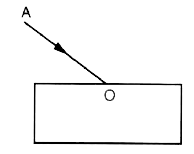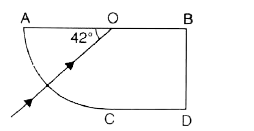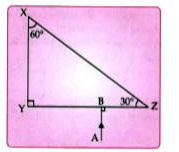A ray of light falls normally on a glass slab. Draw a diagram showing the path of the ray till it emerges out of the slab. What is the angle of incidence and angle of refraction at each surface of slab ?
Step-by-Step Solution:
1. Understanding the Situation: A ray of light is incident normally on a glass slab. "Normally" means that the ray strikes the surface at a right angle (90 degrees) to the surface.
2. Drawing the Diagram:
- Draw a horizontal line to represent the glass slab.
- Draw a vertical line (perpendicular) to the slab to represent the normal line.
- Draw the incident ray coming from above and striking the glass slab at the normal line.
3. Path of the Ray Inside the Slab:
- Since the ray is falling normally, it will pass straight through the slab without bending.
- Draw the ray continuing straight through the slab to the opposite surface.
4. Emergence from the Slab:
- When the ray reaches the second surface of the slab, it will again be incident normally.
- Draw the ray emerging out of the slab, continuing straight in the same direction as it entered.
5. Identifying Angles:
- Angle of Incidence (i): At the first surface, the angle of incidence is 0 degrees (since it is normal).
- Angle of Refraction (r): At the first surface, the angle of refraction is also 0 degrees (the ray continues straight).
- At the second surface: The angle of incidence is again 0 degrees (the ray strikes normally), and the angle of refraction is also 0 degrees (the ray continues straight out).
Summary of Angles:
- At the first surface:
- Angle of Incidence (i) = 0 degrees
- Angle of Refraction (r) = 0 degrees
- At the second surface:
- Angle of Incidence (i) = 0 degrees
- Angle of Refraction (r) = 0 degrees
- Draw a horizontal line to represent the glass slab.
- Draw a vertical line (perpendicular) to the slab to represent the normal line.
- Draw the incident ray coming from above and striking the glass slab at the normal line.
- Since the ray is falling normally, it will pass straight through the slab without bending.
- Draw the ray continuing straight through the slab to the opposite surface.
- When the ray reaches the second surface of the slab, it will again be incident normally.
- Draw the ray emerging out of the slab, continuing straight in the same direction as it entered.
- Angle of Incidence (i): At the first surface, the angle of incidence is 0 degrees (since it is normal).
- Angle of Refraction (r): At the first surface, the angle of refraction is also 0 degrees (the ray continues straight).
- At the second surface: The angle of incidence is again 0 degrees (the ray strikes normally), and the angle of refraction is also 0 degrees (the ray continues straight out).
- At the first surface:
- Angle of Incidence (i) = 0 degrees
- Angle of Refraction (r) = 0 degrees
- At the second surface:
- Angle of Incidence (i) = 0 degrees
- Angle of Refraction (r) = 0 degrees
Topper's Solved these Questions
- REFRACTION OF LIGHT AT PLANE SURFACESBook:ICSEChapter:REFRACTION OF LIGHT AT PLANE SURFACESExercise:EXERCISE-4(A)
Explore 31 Videos
- REFRACTION OF LIGHT AT PLANE SURFACESBook:ICSEChapter:REFRACTION OF LIGHT AT PLANE SURFACESExercise:EXERCISE-4(A) MULTIPLE CHOICE TYPE
Explore 3 Videos
- REFRACTION OF LIGHTBook:ICSEChapter:REFRACTION OF LIGHTExercise:DIAGRAM BASED MCQ:
Explore 5 Videos
- REFRACTION THROUGH A LENS Book:ICSEChapter:REFRACTION THROUGH A LENS Exercise:EXERCISE-5(D) (MULTIPLE CHOICE TYPE)
Explore 2 Videos
Similar Questions
A ray of light falls normally on a rectangular glass slab.
Draw a ray diagram showing the path of the ray till it emerges out of the slab.
View Solution
In the adjacent diagram, AO is a ray of light incident on a rectangular glass slab.
(a) Complete the path of the ray till it emerges out of the slab.
(b) In the diagram, mark the angle of incidence (i) and the angle of refraction (r) at the first interface. how is the refractive index of glass related to the angles i and r ?
(c) Mark angle of emergence by the letter e. how are the angles i and e related ?
(d) Which two rays are parallel to each other ? Name them
(e) Indicate in the diagram the lateral displacement between the emergent ray and the incident ray. state one factor that affects the lateral displacement.
View Solution
Knowledge Check
White light is incident normally on a glass slab. Inside the glass slab,
Ared light travels faster than other coloursBviolet light travels faster than other coloursCyellow light travels faster than other coloursDall colours travels with the same speed.
A ray of light is incident on the surface of a glass plate of refractive index √3 at the polarising angle . The angle of incidence and angle of refraction of the ray is
View SolutionWhen a ray of light enters a glass slab from air
View SolutionWhen a ray of light enters a glass slab from air.
View SolutionA ray of light is incident normally on a plane glass slab. What will be (i) the angle of refraction, and (ii) the angle of deviation for the ray ?
View Solution
A ray of light enters a glass slab ABCD as shown in figure and strikes at the centre O of the circular parth AC of the slab. The critical angle of glass is 42∘. Complete the path of the ray till it emerges out from the slab. mark the angles in the diagram wherever necessary.
View SolutionThe following diagram shows a 60∘,30∘,90∘ glass prism of critical angle 42∘. Copy the diagram and complete the path of incident ray AB emerging out of the prism marking the angle of incidence on each surface.

View SolutionA ray of light falls on a glass plate of refractive index μ=1.5.
What is the angle of incidence of the ray if the angle between the reflected and
refracted rays is 90∘?
View Solution